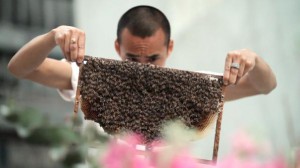 I can’t resist sharing this wonderful video about a guy I found, well, inspirational is the only way I can describe him. And believe me, I don’t often use that word, at least about people. Clicking on the photo will take you to Vimeo. Thanks, Grist.
I can’t resist sharing this wonderful video about a guy I found, well, inspirational is the only way I can describe him. And believe me, I don’t often use that word, at least about people. Clicking on the photo will take you to Vimeo. Thanks, Grist.
Nibbles: Hunger foods, Pollinators, Sacred Seeds, Neglected species, Grasses, Yields, Hawaiian History
- Mining Mungo Park for info about famine foods. Bamboo seeds and, perhaps, baobab pods.
- The big prerequisite for EU funding is a good acronym. STEP — status and trends of European pollinators — gets the go ahead.
- Sacred Seeds project at Missouri Botanical Garden announces new partners in India.
- New Bioversity project to extend importance of work on neglected species in India, Nepal and Bolivia.
- How to manage diverse grasses.
- More on climate change and maize yields. “[I]f anything heat tolerance is declining.”
- Ancient agriculture in Hawaii.
Nibbles: Nabhan, Tilapia, Crowdsourcing taxonomy, Drought, Bees
- Gary Nabhan on the West Bank wall.
- Tilapia not so bad after all?
- Yet another example of crowdsourcing in science.
- Yet another approach to breeding for (mild) drought tolerance.
- Yet another reason why natural history collections are so important.
Sunday delight: pollinators take flight
Spend a few minutes watching this wonderful Ted Talk by Louie Schwartzberg, a film-maker with a thing for time-lapse flowers and slo-mo birds, butterflies, bluebottles, bees, and bats.
Brainfood: Biotechnology, Pollinators, Mulberries, Rice blast, Locavores, Roselle, Cassava, Protected areas, Traditional vegetables, Vitis, European diversity
- Agricultural biotechnology for crop improvement in a variable climate: hope or hype? Your guess is as good as mine.
- Pollinator insects benefit from rotational fallows. They do indeed.
- Biological and productive characteristics of silkworm mulberry varieties of different ploidy and their use for raising silkworms in different seasons. Amazing; more silk faster from polyploid mulberries.
- Mapping quantitative trait loci conferring blast resistance in upland indica rice (Oryza sativa L.). They’re there.
- Food relocalization for environmental sustainability in Cumbria. Fair enough, but what, actually, are the locavores going to eat?
- Relationships among twelve genotypes of roselle (Hibiscus sabdariffa L.) cultivated in western Mexico. Twelve genotypes split into two groups, could be important for breeding and production.
- Variation in qualitative and quantitative traits of cassava germplasm from selected national breeding programmes in sub-Saharan Africa. There is some, but not for everything.
- Global protected area impacts. There are some, but not everywhere.
- Diversity, geographical, and consumption patterns of traditional vegetables in sociolinguistic communities in Benin: Implications for domestication and utilization. 245 species, only 19% cultivated, with big differences among ethnic groups and geographical areas. Research and promotion needs identified.
- Observed trends in winegrape maturity in Australia. 1.7 days earlier per year for 1993–2009, 0.8 days earlier per year for 1985–2009.
- Still a lot of diversity out there, Europe edition: common bean in Sicily, melons near Madrid.